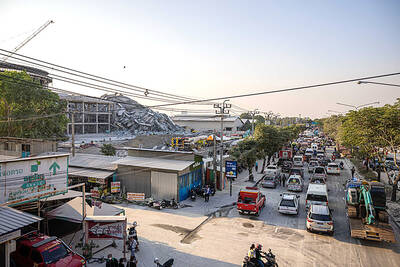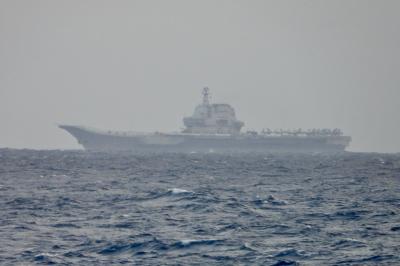The Marine Corps' Guard Division will take over part of the military police (MP) command's duties in guarding the various military general headquarters buildings in Taipei City starting tomorrow. This will be the first time that the Marine guards have been stationed in the capital city.
"This is merely a regular redeployment of the Marines to share some of the MP's duties. The original MP forces will join its Department 202 to strengthen its security measures toward the Presidential Office and the presidential residence," said a spokesman at the Ministry of National Defense.
When asked about local Chinese-language newspaper reports that said the redeployment of the Marines was actually part of the military's response to China's "decapitation strike" strategy -- kidnapping or assassinating the president or other high-ranking government officials before the first shot is fired in an invasion of Taiwan -- the ministry would neither confirm nor deny.
According to the ministry's plan, the Marines' Guard Division will officially begin guarding the Navy General Headquarters, the Air Force General Headquarters and the Logistics Command Headquarters in Taipei City as of Nov. 1. Several Marines have been stationed at these posts over the past month to carry out the necessary preparations for the assignment.
As for the Army General Headquarters in Taoyuan, MPs will still continue to guard the site, but Marines are also expected to be posted there soon. An exact date has not yet been confirmed by the Ministry of National Defense.
Those MPs who used to guard the three headquarters in Taipei City will join Department 202, the division which is in charge of the security measures for the Presidential Office and the presidential residence, and there will be two new units added to the department -- an armored unit and an artillery unit.
As for the Marines' Guard Division, this will be the first time it has been assigned to station and guard military sites in the capital, since its primary duty is to guard naval bases in the south.
The Marines' Guard Division is a unique unit considered to be an elite force of crack troops. A Marine guard's primary duty is to provide security for government installations, and his training regimen includes some of the toughest physical training courses in the military. Marine guards seldom take part in military exercises, as the unit can rarely be spared from its actual duties.
Similar to the qualifications for military police, the Marine Guard Division has strict requirements for its members, including perfect eyesight, a height of at least 175cm, no tattoos, a minimum education requirement of a high school diploma and no criminal record.
A Marine guard is also a qualified sniper and trained to master virtually all types of hand-held weapons which are used by the military forces.
In addition, those who will be selected and assigned to guard the three general headquarters in the capital must also fit three traditional qualifications used to select MPs for the post -- they must be "handsome, tall and smart."

US President Donald Trump yesterday announced sweeping "reciprocal tariffs" on US trading partners, including a 32 percent tax on goods from Taiwan that is set to take effect on Wednesday. At a Rose Garden event, Trump declared a 10 percent baseline tax on imports from all countries, with the White House saying it would take effect on Saturday. Countries with larger trade surpluses with the US would face higher duties beginning on Wednesday, including Taiwan (32 percent), China (34 percent), Japan (24 percent), South Korea (25 percent), Vietnam (46 percent) and Thailand (36 percent). Canada and Mexico, the two largest US trading

AIR SUPPORT: The Ministry of National Defense thanked the US for the delivery, adding that it was an indicator of the White House’s commitment to the Taiwan Relations Act Deputy Minister of National Defense Po Horng-huei (柏鴻輝) and Representative to the US Alexander Yui on Friday attended a delivery ceremony for the first of Taiwan’s long-awaited 66 F-16C/D Block 70 jets at a Lockheed Martin Corp factory in Greenville, South Carolina. “We are so proud to be the global home of the F-16 and to support Taiwan’s air defense capabilities,” US Representative William Timmons wrote on X, alongside a photograph of Taiwanese and US officials at the event. The F-16C/D Block 70 jets Taiwan ordered have the same capabilities as aircraft that had been upgraded to F-16Vs. The batch of Lockheed Martin

GRIDLOCK: The National Fire Agency’s Special Search and Rescue team is on standby to travel to the countries to help out with the rescue effort A powerful earthquake rocked Myanmar and neighboring Thailand yesterday, killing at least three people in Bangkok and burying dozens when a high-rise building under construction collapsed. Footage shared on social media from Myanmar’s second-largest city showed widespread destruction, raising fears that many were trapped under the rubble or killed. The magnitude 7.7 earthquake, with an epicenter near Mandalay in Myanmar, struck at midday and was followed by a strong magnitude 6.4 aftershock. The extent of death, injury and destruction — especially in Myanmar, which is embroiled in a civil war and where information is tightly controlled at the best of times —

China's military today said it began joint army, navy and rocket force exercises around Taiwan to "serve as a stern warning and powerful deterrent against Taiwanese independence," calling President William Lai (賴清德) a "parasite." The exercises come after Lai called Beijing a "foreign hostile force" last month. More than 10 Chinese military ships approached close to Taiwan's 24 nautical mile (44.4km) contiguous zone this morning and Taiwan sent its own warships to respond, two senior Taiwanese officials said. Taiwan has not yet detected any live fire by the Chinese military so far, one of the officials said. The drills took place after US Secretary